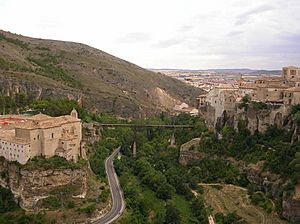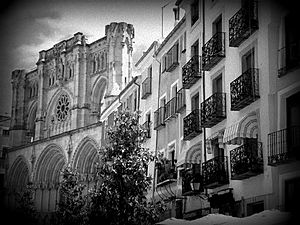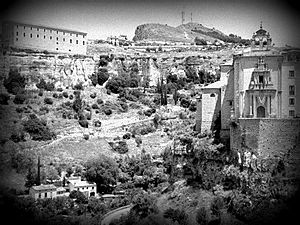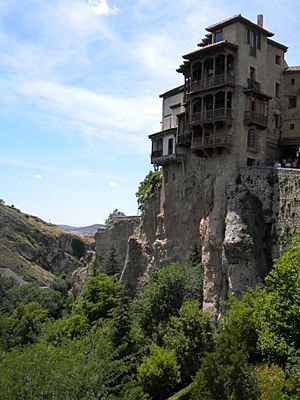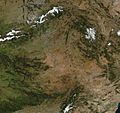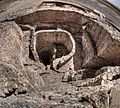Castile-La Mancha facts for kids
Castile-La Mancha is a special region in Spain. It's called an autonomous community, which means it has its own government and rules, similar to a state in some countries. More than 2 million people live here!
The capital city of Castile-La Mancha is Toledo. Some of the other big and important cities include Albacete, Talavera of the Queen, Guadalajara, Ciudad Real, Puertollano, and Cuenca.
Castile-La Mancha is divided into five provinces:
- Albacete province
- Cuenca province
- Guadalajara province
- Ciudad Real province
- Toledo province
Contents
What is Castile-La Mancha Like?
Castile-La Mancha is a large region in the middle of Spain. It has wide, flat plains called mesetas and also some mountains. The weather can be very hot in summer and quite cold in winter.
This region is famous for its history and culture. Many old castles and historic towns can be found here. It's also known for its delicious food, like Manchego cheese.
History of Castile-La Mancha
The area of Castile-La Mancha has a very long history. People have lived here for thousands of years. There are even signs of ancient settlements from the Bronze Age.
During the Middle Ages, this region was a very important place. It was a borderland between Christian kingdoms and Muslim lands. Many battles were fought here.
Important Events in History
In the 12th century, the city of Toledo became a major center for learning. Scholars from different cultures worked together there. They translated important books from Arabic into Latin, sharing knowledge across Europe.
Later, in the 15th century, the region became part of the unified Kingdom of Spain. This was when Queen Isabella I of Castile and King Ferdinand II of Aragon joined their kingdoms.
Economy and Industry
Castile-La Mancha has a diverse economy. This means it has many different ways of making money. Farming is very important here. The region grows lots of grapes for wine, olives for olive oil, and cereals.
Modern Industries
Besides farming, there are other important industries. Some factories produce food products. There are also companies that make things like military helicopters and car parts.
The region is also investing in renewable energy. You can find large solar power plants that use the sun to make electricity. This helps provide clean energy for the area.
Tourism and Culture
Tourism is growing in Castile-La Mancha. People visit to see its historic cities, like Toledo and Cuenca. These cities have amazing old buildings, cathedrals, and unique hanging houses.
The region is also known for its connection to the famous book Don Quixote. This story, written by Miguel de Cervantes, is set in La Mancha. Many visitors come to see the windmills that inspired the book.
Images for kids
-
The Tagus River flows through the province of Toledo.
-
The fortress of Uclés being given to a knightly order in 1174.
-
A view of the petrochemical complex in Puertollano.
-
An NH90 military helicopter assembled in Albacete.
-
The famous Hanging Houses of Cuenca.
-
The Pico del Cervunal and Pico del Lobo mountains in El Cardoso de la Sierra. Pico del Lobo is the tallest peak in the region.
-
The meseta sur plateau near Consuegra, Toledo, with windmills.
-
Natural land formations in Ciudad Encantada.
-
A winery in Manzanares.
-
Jars of honey at a fair in Pastrana.
-
Harvesting saffron flowers in Madridejos.
-
Workers processing garlic in Minaya.
See also
 In Spanish: Castilla-La Mancha para niños
In Spanish: Castilla-La Mancha para niños


